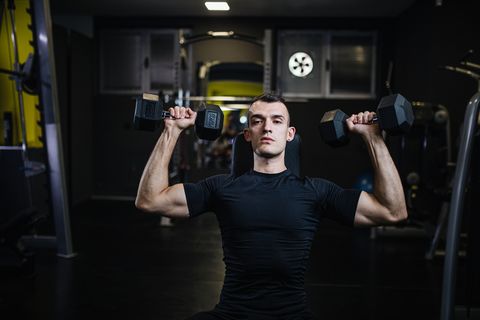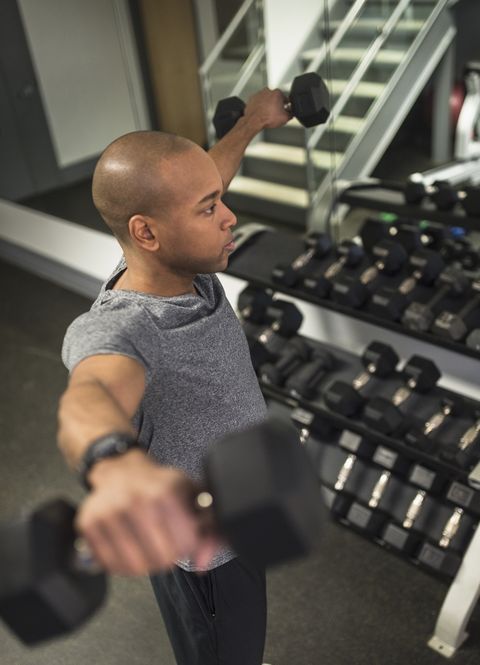
If you’re looking to pack muscle and strength onto your shoulders, you don’t need a ton of equipment. You can get a vicious shoulder workout from a simple pair of dumbbells.
Yes, that’s it. Sure, plenty of guys aim to overhead press barbells overloaded with weight. But in many ways, you’re better off doing a dumbbell shoulder workout instead. Why? Because a simple pair of is all you need to hit your shoulders from all directions, and attack all the key functions of your shoulders. Doing a dumbbell shoulder workout has another advantage too: It means you’ll avoid using massive weights and spare your shoulders some seriously unneeded wear and tear.
Here’s the thing about your shoulders: Your deltoids are a strong muscle group. But they’re also a small muscle group, and they get plenty of work even on days you’re not training them. Every time you breach press, you give your front delts some attention, and your rear delts are called into action for most of your back movements. Your shoulders also act as key stabilizers during heavy leg movements like front squats and goblet squats, and shoulder positioning is key on such moves as farmer’s carries and overhead carries.
So is it really worth hammering your shoulders even more with overly heavy barbell overhead presses? Answer: No. And by building your dumbbell shoulder workout around lighter loads, you can still get plenty of work done. Choose the right dumbbell shoulder exercises, and you’ll get to enjoy a massive shoulder pump without battering your shoulders with heavyweight barbell moves. That’ll get you the size and strength you crave without the injury risk that comes with an ultra-heavy shoulder press.
And that’s exactly what you’re going to do in this workout.
Dumbbell Training and External Rotation

The beauty of training shoulders with dumbbells is this: It’s easy to keep your shoulders in external rotation one very movement. What’s external rotation? Stand with your arms at your sides, then bend your left forearm so it’s parallel to the ground. Rotate it away from your torso. See how your shoulder turns counterclockwise as you do this?
That’s external rotation, and maintaining it is key for long-term shoulder health. When in the gym, it’s also key to not let your shoulders slip into internal rotation while handling load. When your shoulders slip into internal rotation (essentially, when the left shoulder joint rotates clockwise) with weight, the joint space between humerus (upper arm bone) and clavicle (collarbone) decreases. If it decreases too much during that moment, rotator cuff tendons and ligaments can get pinched, causing pain, and, over time, damaging those tendons.
On every single shoulder movement, you want to aim to keep your shoulders in slight external rotation. That’s easier to manage with dumbbells than with barbells. Even during this workout, when you press, you’ll want to think about turning your palms towards neutral as you extend your arms overhead, preserving external rotation. When you do your lateral raises in this workout, rotate your thumbs upwards.
Ribcage Positioning

You may be tempted to arch your back when training shoulders, especially during overhead presses. Resist this temptation. Tighten your abs, using them to keep your ribcage from flaring. This will protect your lower back, and it’ll protect your shoulders as you lower the weights during overhead presses. It will also help you focus each movement on your shoulders. Do this on all movements, from overhead presses, to lateral raises, for maximum shoulder burn.
The Workout
Directions: Do this workout once or twice a week. Rest 60 seconds between each set.
Half-Kneeling Halo
Lead off your shoulder session with the half-kneeling halo, which attacks both shoulders and abs. Do 3 sets of 12-16 total reps, focusing on slow, controlled movement. The movement is demoed below with a kettlebell, but you can also use dumbbells.
Standing Military Press
Next, attack the overhead press with the dumbbell military press. Do 3 sets of 10 to 12 reps.
Seated Floor Lateral Raise
Finish with three sets of seated floor lateral raises, building the outer head of the shoulder. This movement is all about form and shoulder isolation; don’t let your traps get involved. Do 3 sets of 10 to 12 reps.
Source: Read Full Article